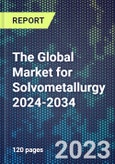Solvometallurgy involves the use of solvents other than water for mineral processing and metal extraction. It can provide environmental and economic benefits compared to traditional processes like pyrometallurgy. With ever increasing global demand from energy and high-tech markets for mined critical minerals and metals such as cobalt, chromium, gallium, germanium, graphite, indium, lithium, manganese, molybdenum, nickel, rare earths, and tellurium, the need to both increase supply and reduce dependence on imports from China is of critical importance. Long-term availability and cost stability of these materials is critical for a low-carbon energy future that will potentially require over 3 billion tons of new minerals and metals to achieve global climate goals by 2050.
Solvometallurgy can contribute to lower greenhouse gas emissions, energy use, and waste production compared to traditional processes, improve metal recoveries and achieve higher yields from ores and waste streams, at a lower cost. The development of the global market for solvometallurgy will be crucial for the extraction and recovery of metals and minerals to meet future demand. Players in the market include start-ups, mining companies and chemical producers.
Report contents include:
- Technology analysis
- Description of other processes.
- Market drivers and challenges.
- Key technologies and processes including
- Solvent Extraction.
- Bioleaching.
- Chloride/Chlorine Leaching.
- Supercritical Fluid Extraction.
- Ionic Liquids.
- Heap Leaching.
- Direct Solvent Extraction.
- Pressure Oxidation Leaching.
- Microwave Heating.
- Ultrasound-Assisted Leaching.
- Resin-in-Pulp.
- Electrowinning.
- Advanced materials
- Metal-Organic Frameworks (MOFs).
- Deep eutectic solvents.
- Nanoparticles.
- Carbon nanotubes.
- Conductive polymers.
- Bio-materials.
- Analysis of Metals and minerals processed and extracted including:
- Copper.
- Nickel.
- Cobalt.
- Rare Earth Elements (REE).
- Lithium.
- Gold.
- Uranium.
- Zinc.
- Manganese.
- Tantalum.
- Niobium.
- Indium.
- Gallium.
- Germanium.
- Antimony.
- Commercial solvometallurgy market analysis:
- Current state of the market and future outlook.
- Market players.
- SWOT analysis.
- Market map & value chain.
- Historical and current market size estimates.
- Profiles of 43 companies. Companies profiled include BacTech, BASF, Berkeley Energia, EnviroMetal Technologies, Metso, PH7, and Sumitomo Metal Mining.
This product will be delivered within 1-3 business days.
Table of Contents
1 RESEARCH METHODOLOGY2 TERMS AND DEFINITIONS
Companies Mentioned (Partial List)
A selection of companies mentioned in this report includes, but is not limited to:
- Atlas Chemical Industries
- BacTech Environmental Corporation
- BASF
- Berkeley Energia
- Brazilian Nickel PLC
- Cheetah Resources
- Clariant
- Dow Chemicals
- Dundee Sustainable Technologies
- DuPont
- eCobalt Solutions
- EnviroMetal Technologies
- Freeport McMoRan
- Fluor
- FLSmidth
- Glencore
- Glory Resources
- Hatch
- Henkel
- IXOM
- Jervois Global
- Jetti Resources
- Kemira
- Metso
- Namibia Critical Metals
- Neometals
- NioCorp Developments
- Nouryon
- Peninsula Energy
- PH7
- Rio Tinto
- Search Minerals
- Solvay
- Solvometallurgical Technologies
- STEAG
- Sumitomo Metal Mining
- SNF Floerger
- Taguang Technology
- Tantalus Rare Earths
- Teck Resources
- Tenova
- Tetronics
- Thermax
- Zeobond
Methodology

LOADING...








